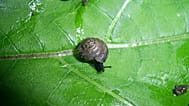The German hairy snail has become one of the most endangered molluscs in the UK, but new efforts could soon turn that around.
The race to save the elusive German hairy snail is well underway, as conservationists and citizen scientists join forces in a city-wide mission.
More than 100 volunteers are taking part in a series of surveys, led by Citizen Zoo and the Zoological Society of London (ZSL), to better understand the distribution of the at-risk species across London and inform conservation efforts.
However, coming in at the size of a fingernail, finding these rare snails – which are classed as one of the most endangered molluscs in the UK – will be no easy feat.
The ‘charming’ Germany hairy snail
Joe Pecorelli, a freshwater conservation programme manager at ZSL, says the “charming little snail” has been living in riverbanks and wetlands for thousands of years.
While the species wasn’t recorded in Britain until 1982, fossilised remains indicate it has been here since at least Neolithic times, and has potentially been around as far back as the last Ice Age, when Britain was still joined to mainland Europe.
The German hairy snail gets its name from the tiny fibres that cover its shell, which help it retain moisture and cling to riverside plants and debris that it feeds on.
However, due to drivers such as habitat loss and pollution, the snail’s population has significantly declined. In the UK, it is thought the species is now restricted to just a “few sites” of fragmented patches along the River Thames.
‘Safeguarding’ green spaces
“These surveys will help us understand how the snail is faring and how we can protect it, not only securing their future for years to come but also helping safeguard green spaces throughout London for people and wildlife for future generations,” Pecorelli adds.
So far, the survey team, which is also backed by partners including London Wildlife Trust, the Conchological Society of Great Britain and the Port of London Authority, has found the snail in several locations, including in Richmond upon Thames, Iselworth Ait and near Kew.
Director of rewilding at Citizen Zoo Elliot Newton says he was “over the moon” when he found his first German hairy snail - describing them as “beautiful, curious-looking” creatures.
"The surveys show how, by working together across the capital with many partners and empowering local communities, we can gain a deeper understanding of London's more hidden biodiversity and take steps to protect it,” he adds.


















